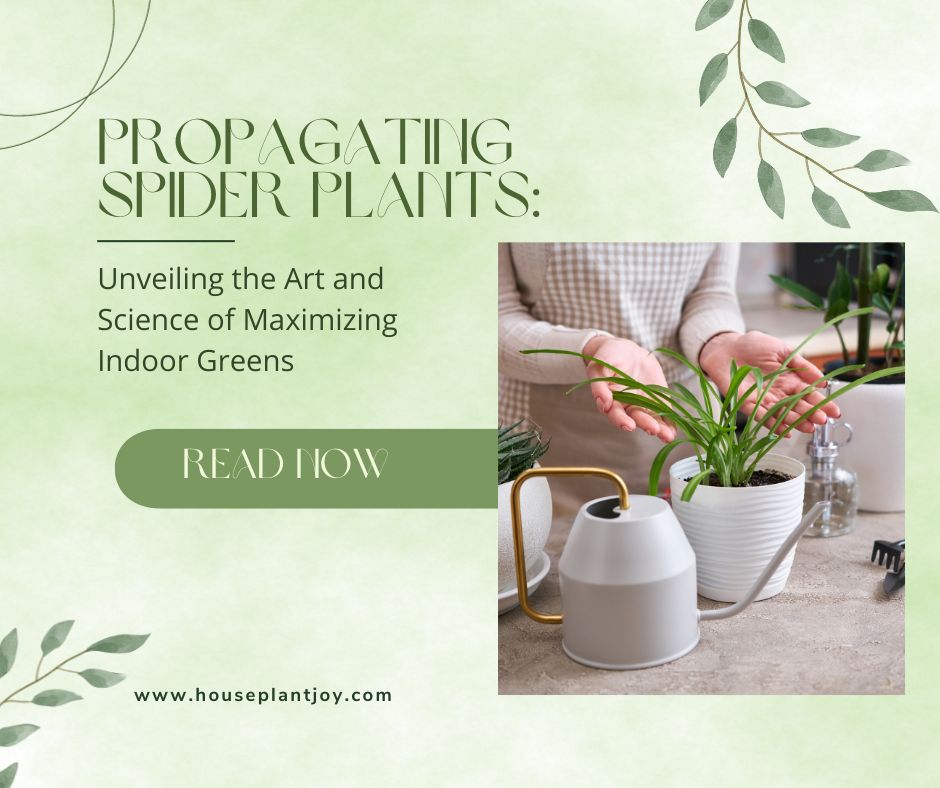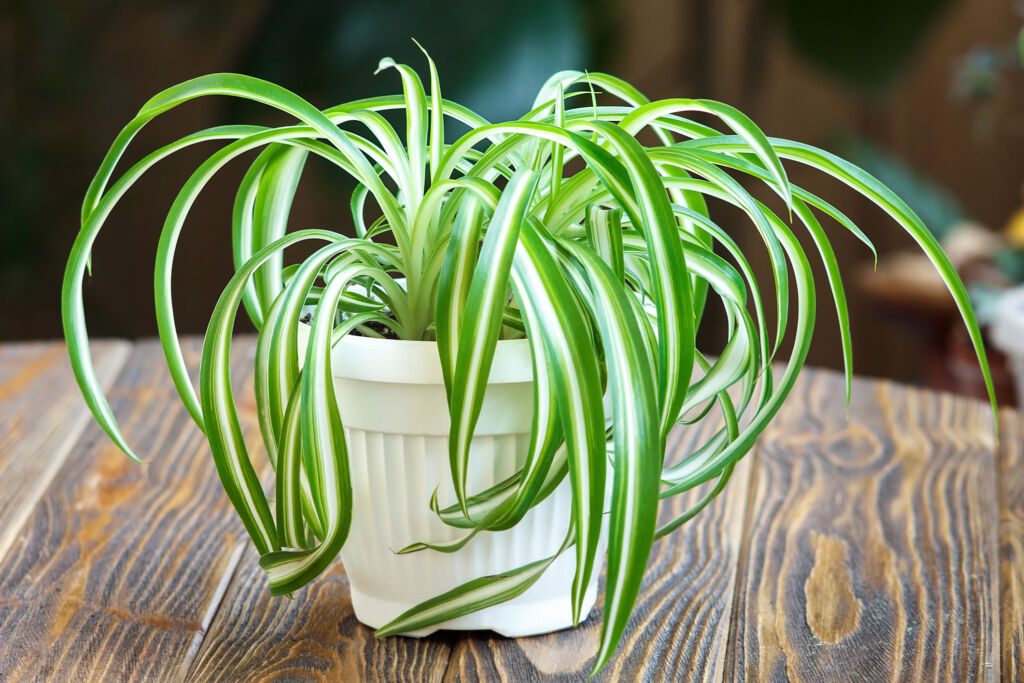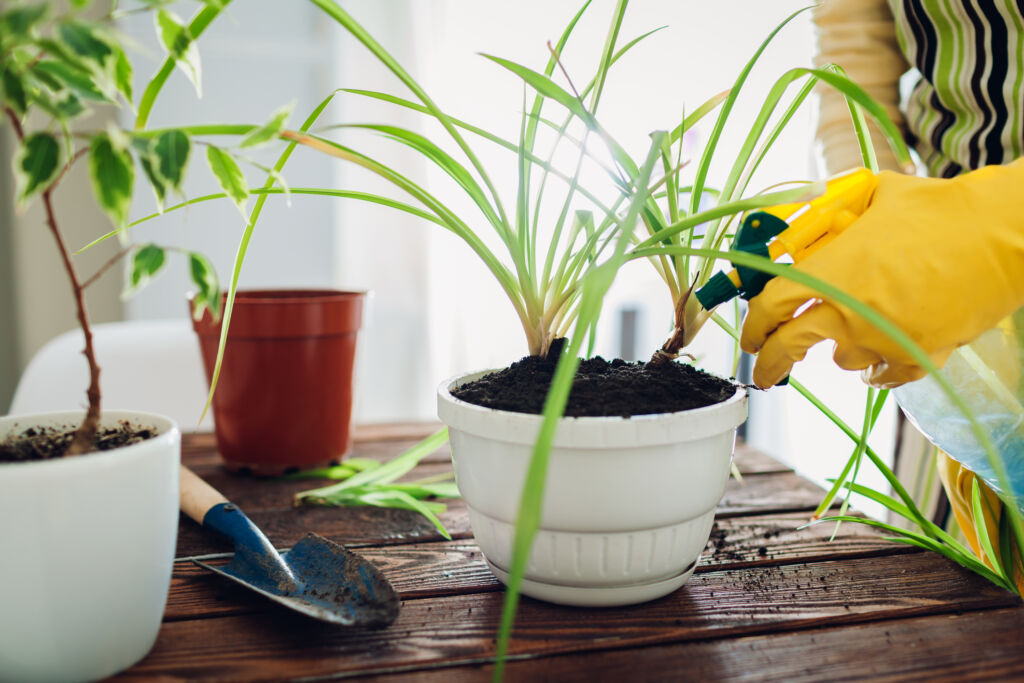HousePlantJoy is supported by our audience. When you purchase through one of our links, we may earn a small affiliate commission. As an Amazon Associate I earn from qualifying purchases. Your cost is not affected.
==================
Picture this: a world where your home is a lush, green sanctuary. Every room is alive with vibrant energy, and the air you breathe is as fresh as a morning breeze. That’s the magic of spider plants! With their elegant leaves and adorable baby spiderettes, these green wonders are more than just houseplants; they’re your companions in creating a thriving indoor oasis. But here’s the best part: propagating spider plants is a breeze, and you don’t need a green thumb or a degree in botany to do it. So, let’s embark on this journey together and discover the secrets of spider plant propagation. It’s an adventure that’s accessible to everyone, and I promise it’ll make your home greener and more vibrant than ever before!
Propagating Spider Plants
If you’re anything like me, the joy of watching your indoor garden flourish is unmatched. Now, imagine enhancing that lush greenery by propagating spider plants. Sounds exciting, doesn’t it?
Spider plants, with their long, arching leaves and adorable baby plants, have a special place in the hearts of plant parents. They’re not just about the aesthetics. These green beauties purify the air, making your indoor space a breath of fresh air – literally!
But here’s the golden nugget – propagating these plants is as easy as pie. You don’t need a degree in Botany or magical green fingers. With simple steps, you’ll witness a mesmerizing green explosion in your space. Ready to dive into the world of spider plant propagation? Stick with me, and let’s unfold the mystery together!
If terms like “spider plant babies” or “airplane plant” make you scratch your head, worry not! We’re going to decipher all these and more. By the end, you’ll not only be well-versed but ready to propagate your spider plant like a pro. Enjoy reading!
What Are Spider Plants?
Now that we’re all geared up, let’s take a moment to get to know these green darlings a bit better. The spider plant is also known by its scientific name, Chlorophytum comosum. Sounds fancy, doesn’t it? Understanding spider plants is the first step in the magical journey of propagation.
Spider plants have this captivating way of growing, with their long, graceful leaves that dance in the air, giving life and energy to any room. But it’s the baby spider plants, or spider plant babies as some like to call them, that steal the show. They sprout from the mother plant, making them look like they’re floating in the air. It’s a spectacle of nature’s beauty!
Have you heard of the term “airplane plant” before? Well, it’s just another name for our beloved spider plants. Cool, right? These plants have a talent for adapting, and that’s one of the many reasons plant lovers like us are smitten by them.
Why Propagate Spider Plants?
Now, while these green gems are known for their hardiness, they’re not immune to a few hiccups here and there. Brown tips on the leaves can be a common sight. But no worries, we’ll tackle how to manage and prevent this to keep your plant as green and vibrant as ever!
Learning the lifecycle of the spider plant, from the mother plant to the baby plants, is essential. It gives us a roadmap to propagate spider plants with success.
Ah, now we’ve arrived at an interesting junction – why bother propagating spider plants, you ask? Well, friend, buckle up, because the benefits are both delightful and numerous!
First off, spider plants are like a gift that keeps on giving. Each mother plant births adorable baby spider plants. They open a world of endless green possibilities. You can transform a corner of your room into a green sanctuary. Or you can share the joy by gifting baby plants to friends and family. Who doesn’t love a gift that grows, right?
And let’s talk about the air-purifying wonders of spider plants for a moment. Each new spider plant is another natural air purifier that joins your indoor space. It’s like having an army of green warriors. They filter out pollutants and gift you with fresh, clean air.
Ever heard the phrase ‘more the merrier’? It couldn’t be more true here. By propagating spider plants, you aren’t just increasing the number of your plants but also the diversity of your indoor garden. Each plant, with its unique pattern and form, adds a distinct touch.
Now, here’s the cherry on top. Propagating spider plants is as easy as a walk in the park. The simplicity of the process is bound to make you fall deeper in love with these green gems.
Step By Step on How to Propagate Spider Plant
Propagating spider plants is a joyous journey, and I’m here to walk you through each step. Trust me; it’s as easy as pie!
1. Identify the Babies
Every adventure begins with a first step. In spider plant propagation, it starts with identifying the baby spider plants. These little green bundles of joy sprout from the parent plant, showing off their long stems and vibrant leaves.
2. The Right Time
Timing is key, my friends. Ensure the spider plant babies have developed roots. They often appear as tiny roots, making them ready for the big move. The growing season, usually in spring or summer, is the ideal time for this green operation.
3. Gather Your Tools
Now, make sure you have the right tools. A sharp knife, some small pots filled with well-draining soil or potting mix, and your eager baby plants. Remember, ensuring drainage holes at the bottom of the pots is crucial. We want those roots breathing easy!
4. The Gentle Separation
Use your sharp knife to gently separate the baby spider plants from the main plant. It’s like cutting the apron strings – a moment of green independence!
5. The Planting Magic
Place the baby plants in the small pots with potting soil, making sure not to bury them too deep. We’re aiming for a cozy fit, with the roots snugly placed and the leaves basking in the indirect light.
6. The Water Touch
Water the new spider plants just enough to make the soil moist. We’re not looking for a mud bath here, just enough moisture to make the roots feel at home.
7. The Waiting Game
Now, it’s time for a little patience. Keep the soil slightly moist and watch for new growth. A gentle tug can reveal if the plant’s roots have taken hold. If you feel resistance, congratulations – roots are forming!
8. Witness the Green Magic Unfold
As the roots grow stronger and new growth appears, you’ve officially entered the club! Your spider plant babies are now thriving plants. They’re ready to purify the air and add aesthetic beauty to your space.
Propagating Spider Plants in Soil Vs. Water
When it comes to propagating spider plants, there are two intriguing avenues to explore: the soil route and the waterway. Each of these methods has its unique charm and dedicated fan base, so let’s embark on an exciting journey to uncover both!
Let’s begin with the timeless classic – soil propagation. It’s as natural as can be. Take those adorable baby spider plants and nestle them snugly into a welcoming pot filled with well-draining soil. Now, sit back and behold the enchanting spectacle that unfolds. Roots will grow, leaves will stretch out, and before you know it, voila! A brand-new spider plant comes to life. This method, cherished for its simplicity and effectiveness, has been a reliable choice for plant lovers for generations.
But wait, there’s another tale to tell – water propagation. Picture your baby spider plants suspended gracefully in water, their delicate roots unfurling within a transparent vessel. It’s not just a treat for the eyes; it’s a captivating science lesson in real-time. Witnessing those tiny roots emerge and dance gracefully in the water is nothing short of mesmerizing. And it offers you a front-row seat to the incredible marvel of root growth.
So, the question remains: soil or water? It’s akin to choosing between a cozy cottage and a beachfront villa – both alluring in their own special ways. Soil propagation is your reliable, comforting choice, akin to the warmth of home. The baby plants establish their roots in familiar territory, enveloped by the nurturing embrace of the soil.
On the other hand, water propagation is like an exciting and unpredictable vacation. It’s a journey of discovery where you can observe the roots grow day by day, unveiling a live showcase of nature’s wonders. So, which path will you choose for your spider plant propagation adventure?
Caring for Your New Spider Plants
Congratulations, you’ve successfully propagated your spider plants! But hold on, the journey isn’t over yet. The aftercare stage is where your green babies grow into mature, air-purifying wonders. Let’s ensure those new spider plants not only survive but thrive!
Watering
Your baby plants are like newborns. They need just the right amount of care. Keeping the soil moist is key, but remember, moderation is the mantra. Too much water? No good. Too little? Nope. Aim for the golden middle – soil that’s slightly moist and happy.
Light and Location
The location of your new spider plants matters a lot. Bright, indirect light is their best companion. Direct sunlight can be a bit harsh for these young ones. So, finding a spot where they can enjoy the light without getting scorched is your mission.
Feeding Your Green Babies
Even plants get hungry, and feeding them is a joy. However, these baby plants are still taking baby steps. There is no need for a full-course meal. Just a light feeding now and then during the growing season to keep them vibrant is enough.
Managing Brown Tips
If you notice brown tips on your new spider plants, don’t panic. It’s a common hiccup. Adjusting the watering frequency and ensuring the plant isn’t exposed to direct sunlight are important.
Repotting
As your baby plants grow, they might outgrow their initial pots. If the roots look like they’re trying to escape, it’s time for a move. You can repot into a slightly bigger pot. This ensures those growing roots have ample space to stretch.
Common Problems and Solutions When Propagating Spider Plants
In the enchanting realm of spider plants, it’s not always a picture-perfect journey filled with sunshine and rainbows. Every now and then, as we tend to our green companions, we might stumble upon a few unexpected challenges. But fret not, my fellow plant enthusiast! I’m here to lend a helping hand, guiding you through these occasional green hurdles with the utmost ease and reassurance. Together, let’s transform those moments of uncertainty into opportunities for growth and turn those initial frowns into joyful, leafy grins!
Brown Tips
Ah, the infamous brown tips. It’s like a rite of passage for every spider plant parent. The culprit? Often, it’s the water. Consider using distilled water. Or you can leave tap water out overnight before watering your green buddies. Your spider plants will thank you with vibrant, green leaves.
A Crowded Home
As your spider babies grow, they might feel a bit cramped. If you notice the roots becoming root-bound or the plant outgrowing its pot, it’s time for a new home. Repotting into a larger space gives your plant room to breathe and grow.
Lighting Woes
Too much light or too little, it’s a balancing act. If your spider plant’s leaves are losing their vibrant green, it might be getting too much direct sun. A location with bright, indirect light will make for a happy, green plant.
Waterlogged Woes
If the leaves of your spider plants are turning yellow or brown, you might be showering them with too much water. Ensure the pot has drainage holes and let the soil dry out between watering.
Fading Green
Spider plants love nutrients. If the vibrant green is fading, it might be a cry for some plant food. A mild, balanced fertilizer during the growing season is like a green buffet for your plants. They’ll dine and shine!
Video Credit: @HarliG
Wrapping It Up
What a journey it’s been, right? We’ve been in the thick of it, getting to know the secrets of leaves, roots, and the beautiful blossoms. But you know what’s truly special about spider plants? It’s not just about their graceful leaves or their remarkable air-purifying abilities. It’s about the entire adventure, from the moment those baby spider plants burst onto the scene to the day they find their new home in a pot of their own.
Propagating spider plants, well, it’s more than just growing plants, my friends. It’s like being a front-row spectator to nature’s dance, a performance where every root and leaf has a story to tell. It’s a silent but profound connection between us and the world of green.
Remember, patience is your trusted partner in this journey. Each spider plant has its own rhythm, its own dance through the changing seasons. Sometimes, it’s a swift waltz; other times, it’s a slow, graceful adagio unveiling the beauty of green.
So, keep in mind that you’re not just nurturing plants; you’re composing a symphony of growth and green magic. Let every leaf be a note, every root a verse in your unfolding masterpiece. Here’s to vibrant greens, pure air, and the subtle melodies of spider plants that fill our spaces with the essence of nature. Happy planting, and here’s to a world where green wonders await around every corner!
FAQS
How Often Should I Water My New Spider Plants?
Ah, a question as old as time (or at least as old as spider plants have been adorning our homes!). Keeping the soil slightly moist is the golden rule. But remember, these green gems don’t fancy a soggy abode. If you touch the soil and it feels dry, it’s a cue for a water gala. Just ensure the pots have drainage holes to avoid waterlogged soil, and those roots will be fine.
Can I Propagate Spider Plants in Any Season?
Great question! While these green darlings are quite the hardy bunch, they have a soft spot for the growing season. Spring and summer are like the blockbuster seasons for propagating spider plants. The warm temperatures and abundant light create the perfect backdrop for new growth. It’s nature’s way of rolling out the green carpet for the new babies!
How Do I Know When My Spider Plant Babies Are Ready to Move to Their Own Pot?
Patience, my friend, is the secret sauce here. Give those baby spider plants some time to grow and develop roots while still attached to the parent plant. When you spot roots forming and the babies have a few leaves of their own, it’s a green signal! It’s like they’ve graduated and are ready to step into the world (or pot) on their own. A moment of silent pride for every plant parent!
Plant Lovers Unite!
Looking for a slice of green heaven in your social media feed? Look no further! Join our passionate plant propagation community on Facebook, Instagram, Pinterest, and Twitter. ?
? Immerse yourself in captivating content, discover product reviews, and connect with fellow green enthusiasts. From propagation tips to garden transformations, our social spaces are bursting with inspiration. Don’t miss out on the vibrant conversations and joyful plant-sharing moments! ?
Ready to take your green journey to the next level? Subscribe to our newsletter for the latest updates, exclusive content, and a blooming good time. ? Let’s grow together and cultivate the joy of gardening, one leaf at a time! ? #HouseplantJoy ?












